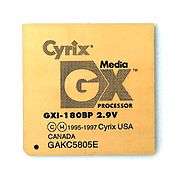MediaGX
The MediaGX CPU is an x86 compatible processor that was manufactured and designed by Cyrix and later after merger manufactured by National Semiconductor, and was introduced in 1997. The core is based on the integration of the Cyrix Cx5x86 CPU core with hardware to process video and audio output (XpressRAM, XpressGRAPHICS, XpressAUDIO). Following the buyout of Cyrix by National Semiconductor and the sale of the Cyrix name and trademarks to VIA Technologies, the core was developed by National Semiconductor into the Geode line of processors, which was subsequently sold to Advanced Micro Devices.
| General Info | |
|---|---|
| Launched | 1997 |
| History | |
| Successor | Geode |

Whether this processor belongs in the fourth or fifth generation of x86 processors can be considered a matter of debate as the processor was based on the 5x86 (a scaled down version of the Cyrix 6x86). While the 5x86 was intended to compete with the Intel Pentium line, the 5th generation x86, it was designed to interface with a 4th generation (80486) motherboard and had only the 486's instruction set, lacking the ability to run software requiring the Pentium's new instructions.
The MediaGX CPU was mostly used for subcompact laptops. It was also used in the CTX EzBook V92C266, Compaq Presario 1220 and 1230 laptops, Compaq Presario 2100 and 2200 desktops, Casio Cassiopeia Fiva tablet PC, and many others, as well as in high-performance embedded applications such as the Pinball 2000 arcade pinball system and Atari Games arcade platforms. Sun Microsystems used MediaGXm in the Dover JavaStation.
Virtual Subsystem Architecture
Virtual Subsystem Architecture (VSA) emulates a presence of the real hardware VGA (XpressGRAPHICS) and Sound Blaster (XpressAUDIO). The access to the hardware resources traps via BIOS and emulates in the System Management Mode (SMM), enabling it to execute transparently to the operating system, drivers and applications.[1]
Media GX
- Manufacturing process: 0.4 μm
- Cache: L1 16 KB unified
- Core speed: 120, 133, 150 MHz
- Bus speed: 33 MHz
Media GXi

Cyrix MediaGXi is an improved version of the MediaGX.
- Manufacturing process: 0.35 μm
- Cache: L1 16 KB unified
- Core speed: 120, 133, 150, 166, 180 MHz
MediaGXm

The MediaGXm is an improved MediaGX with an implementation of the MMX enhanced instruction set.
- Manufacturing process: 0.35 μm 4-layer metal CMOS process
- Core speed: 180–266 MHz
- Bus speed: 33 MHz
- Cache:
- L1 cache size 16 KB write-back 4-way set associative unified I/D cache.
- Or 12-Kbyte unified L1 Cache and 4K scratchpad for SMM & Graphics.
- Integrated peripherals:
- PCI controller
- Display controller and 2D graphics accelerator
- Hardware MPEG-1 supports fullscreen video playback
- 16-bit audio subsystem Sound Blaster 16/Pro compatible
- 64-bit SDRAM controller
- V core: 2.9 V
- V I/O: 3.3 V
- Package: 320-pin Ceramic PGA; 352-ball BGA
- System chipset: Cx5520 352-pin BGA
National Semiconductor offered this processor under the name Geode GXM.
Disadvantages
The MediaGX platform does not provide for external Level-2 cache memory, typical for motherboard designs of the period. All of the cache must be on the processor die.
MediaGX processors can only run on motherboards specifically designed for the same model of the processor due to tight integration between the processor and its companion chipset.
The graphics, sound, and PCI bus ran at the same speed as the processor clock also due to tight integration. This made the processor appear much slower than its actual rated speed. However, the graphics system is able to use the main system memory providing for significant cost savings on the basic systems and embedded controllers in the market for this platform.
References
- Gwennap, Linley (10 March 1997). "MediaGX Targets Low-Cost PCs". Microprocessor Report.
See also
- Cyrix
- Cyrix Cx5x86
- National Semiconductor
- Geode (processor)
- AMD
External links
- GXM Product Folder at National Semiconductor (archived version 2007)
- AMD Geode Solutions
- Cyrix MediaGX and National Semiconductor Geode Information
- Cyrix MediaGX
- Cyrix